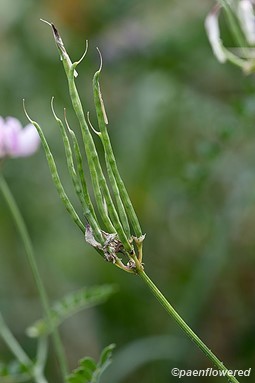Securigera varia
A European plant introduced to U.S. for purpose of beautification
Securigera varia crownvetch
Add to MyPlants View Locations
Sometimes introducing a plant to a new area is a good idea, but not very often. It is not surprising that you will find crown vetch, a perennial species of the pea family growing along the sides of roads. This European plant was purposely introduced to the United States for beautification and to control erosion along highways. Often the seeds were sprayed on embankments from trucks. It forms large colonies by means of its underground rhizomes and has spread by seed to enough other areas to often qualify as a troublesome weed. Sometimes heavy growth of crown vetch can be difficult to walk through and may hide yellow jacket ground nests.
It is not a true vine because it produces no tendrils, but it will grow over other objects and vegetation. It will tolerate poor soils and dry, sunny conditions, though its growth in these areas is less vigorous than on moist and more fertile soil. It seems to suffer from few plant diseases and has no major insect pests.
It has a pink and white, clover-like cluster of flowers (an umbel) on a stalk that rises above the creeping stems and leaves that are divided into many paired leaflets, giving them a fern-like appearance. It blooms from June to August. The flower stalks arise from the leaf axils. Each individual flower cluster is about one inch in diameter. The leaves are 2-4 inches long.
The plant can grow 1-2 feet high, but much longer horizontally. When the crown vetch grows in dense patches it can make a strikingly beautiful groundcover. Since it is a legume it does, like most members of the pea family, enrich the soil with nitrates. The fruit is a 1 to 2 inch long linear pod with four angles. All parts of the plant are very poisonous and most mammals avoid eating it. Insects do use it as a source of nectar.
Habitat & Range
Grows alone highways, roadsides, fields.
Present throughout the state.
Wetland code: Not classified
Phenology
Flowers June to October.
Securigera varia crownvetch
Synonyms: Coronilla variaAdd to MyPlants View Locations







Comments
Have you spotted this plant in your area? We'd love to hear about your experience! Share your comments or questions about the plant below. Comments are moderated before posting.